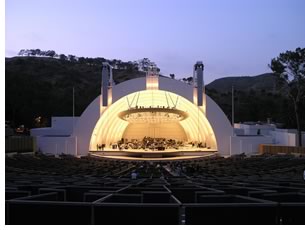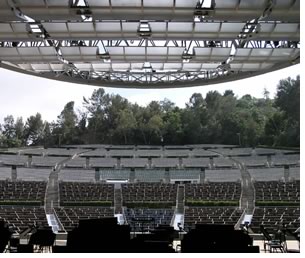

09/2004
 Hodgetts
+ Fung Design and Architecture, devoted to preserving the rich history
of a Los Angeles icon, has reinterpreted the Hollywood Bowl’s trademark
creamy-white curvilinear shell while infusing advanced technologies to
provide the world-class acoustics envisioned by the founders.
Hodgetts
+ Fung Design and Architecture, devoted to preserving the rich history
of a Los Angeles icon, has reinterpreted the Hollywood Bowl’s trademark
creamy-white curvilinear shell while infusing advanced technologies to
provide the world-class acoustics envisioned by the founders.
Partners Craig Hodgetts, AIA, and Hsin-Ming Fung, AIA, worked closely with a team of consultants and engineers to combine classic lines and streamlined technology to echo the glamorous associations of the Bowl’s history. “Our objective was to create a rare evening experience blending the glamour of a Hollywood premiere with the lush background of the Hollywood Hills,” Hodgetts says.
 A
Wrightian influence
A
Wrightian influence
The new Hollywood Bowl shell marks the fifth constructed since it was
built in 1922. Hodgetts + Fung’s design replaces the 1929 shell,
designed by Elliott, Bowen and Walz. In 1928—one year after building
a temporary wood shell—Lloyd Wright, son of Frank Lloyd Wright,
designed the Modern shell that remains its trademark shape. That shell,
however, was demolished after it deteriorated from being left unprotected
in winter. The original bowl, which stood for five years, was a simple
wood platform with a canvas shell; a wood proscenium was added in 1926.
Hodgetts + Fung’s plans resonated with county residents and the Los Angeles Philharmonic, which considers the Hollywood Bowl one of its two homes. Voters in 1996 approved a $25-million upgrade, and commissioned Hodgetts + Fung to create new solutions for the Hollywood Bowl. After experimenting with several options—including retaining the 1929 structure in some form—the architects proposed a new approach with a halo-like acoustic canopy to accommodate the architects’ environmental-impact analysis, community’s desires, and practical needs of the Philharmonic. In October 2003 construction began on the new design, which included a re-conception of the arch, advanced digital sound reinforcement system, and expansive stage. Flanking the arch are dramatic, stepped wings harking to the Bowl’s 1920s beginnings. Behind the wings are new backstage areas, completed in collaboration with executive architect Gruen Associates.
 State-of-the-art
acoustics
State-of-the-art
acoustics
In addition to upgraded acoustical features, the new configuration expands
the stage by 30 percent to accommodate the full Philharmonic orchestra
within the arch, where previously some musicians were forced to play outside
of the shell. The historic shell’s interior conical shape did not
meet acoustic needs, yet had become familiar to millions of Bowl patrons.
Through careful analysis, the architects gave the shell the appearance
of the original cone shape. Hodgetts + Fung also positioned knife-thin
baffles that line the interior walls to recall the visual effect.
The architects worked with Jaffe Holden Acoustics to incorporate innovative technologies to solve the acoustical problems that have afflicted the bowl since its creation. The highlight of the new shell’s acoustic features is the grand canopy, which floats as an elliptical ring above the stage and reflects sound waves to all parts of the stage. A series of computerized translucent louvers extends across the ring and is programmed to shift into place according to the type of music being performed. The canopy allows performers to hear each other on stage—a goal that had never been previously achieved.
 Hodgetts
+ Fung says the bowl will adapt to future demands. Working with theater
consultant Fisher Dachs Associates, the team devised an adaptable-stage
design to accommodate touring groups and performers. Expanding the roof
and making the suspended ellipse partially removable increases the proscenium
height to 60 feet, adding even more flexibility. Lighting and sound equipment,
which can be customized for each performance, are stored above the acoustic
canopy. Three towers above the exterior shell support linear arrays of
vertically suspended speakers, which curl just below the proscenium to
complement the ellipse and ensure the seamless visual flow of the bowl’s
regal arch.
Hodgetts
+ Fung says the bowl will adapt to future demands. Working with theater
consultant Fisher Dachs Associates, the team devised an adaptable-stage
design to accommodate touring groups and performers. Expanding the roof
and making the suspended ellipse partially removable increases the proscenium
height to 60 feet, adding even more flexibility. Lighting and sound equipment,
which can be customized for each performance, are stored above the acoustic
canopy. Three towers above the exterior shell support linear arrays of
vertically suspended speakers, which curl just below the proscenium to
complement the ellipse and ensure the seamless visual flow of the bowl’s
regal arch.
Copyright 2004 The American Institute of Architects.
All rights reserved. Home Page ![]()
![]()
 |
||
|
|
||